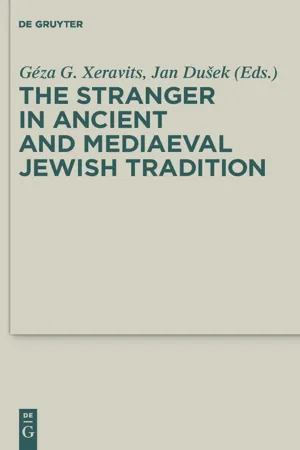
The Stranger in Ancient and Mediaeval Jewish Tradition
- 259 pages
- English
- PDF
- Available on iOS & Android
The Stranger in Ancient and Mediaeval Jewish Tradition
About This Book
This volume presents selected papers read at the first meeting of the Society for Jewish and Biblical Studies in Central Europe, in Piliscsaba, Hungary, February 2009, but does not publish the proceedings of this meeting (for a clarification see here ). The papers investigate various aspects of the concept "Stranger" in Jewish tradition, from the Hebrew Bible to Mediaeval Jewish thought. The bulk of the material focuses on Early Jewish literature, which mirrors an intensive interaction with the Hellenistic system of thought, and the development of concurring Jewish interpretations of traditional values.
The papers of the volume provide insightful case studies about the formation of Jewish identity in diverse periods of Israelite and Jewish history, as well as the different attitudes to strangers, being either outsiders, or belonging to opposing sects of Judaism itself. The reader finds essays of historical, literary, and hermeneutical attention; of interest also to scholars of various forms of ancient and mediaeval Judaism.
Frequently asked questions
Information
Table of contents
- Frontmatter
- Table of Contents
- Wem und wohin gehörte Atarot?
- “Strangers to One Another” The Motif of Strangeness in the Jephthah-Cycle
- Some Reflections on the Foreigner in the Dedicatory Prayer of Solomon
- Identität wahren — Integration fördern. Überlegungen auf dem Boden des Alten Testaments
- Der Fremde bei Ben Sira. Die Spannungen zwischen der spätalttestamentlichen und hellenistischen Weltauffassung
- “Stranger in a Strange Land”. Tobiah’s Journey
- Le rapport au monde étranger à l’époque hellénistique et ses changements dans le livre de Judith et dans les inscriptions historiques des Psaumes
- Die Beziehung der Makkabäer zu fremden Nationen — die Bündnisse mit Rom und Sparta
- „Ein Bethaus — für alle Völker?“ Tempel, Völker und prophetischer Heilsuniversalismus im ersten Makkabäerbuch
- Women as Strangers in Ancient Judaism: The Harlot in 4Q184
- “Strange Prophet Behind the Scenes” Balaam’s Anonym Prophecies as Key Texts of the Messianic Ideas and Biblical Interpretations of the Qumran Community
- The Use of Rhetoric in the Creation of a “Rabbinic” Identity in the Discourse of Rabbinic Literature
- Identification with a Woman? The Hannah Figure in the Babylonian Talmud (Berakhot 31a‐32b)
- Jews and Romans as Friends and Foes according to Sefer Josippon
- Backmatter